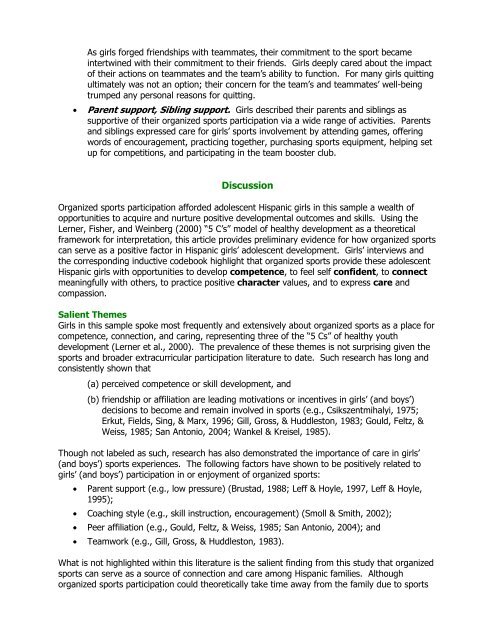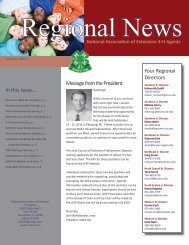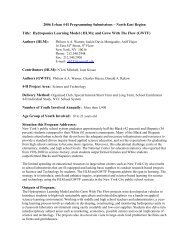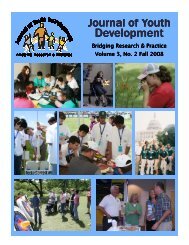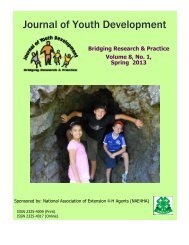ecause <strong>of</strong> him (the coach)…. You depend on that person to always be there. Andthen, they just leave. You know? I don’t think it’s right… Stick together.• Positive coaching. Some coaches served as positive adult figures in these girls’ lives.Girls particularly praised the coach <strong>of</strong> the 9 th grade volleyball team who prioritizedhaving fun, skill instruction, and positive reinforcement among a team comprised <strong>of</strong>many girls who had limited or no volleyball experience. This coach was also a 9th-gradeteacher at the school and understood when girls needed to miss practice for tutoring.• Family sports, Parent support, Sibling support. Girls’ narratives about their sportsinvolvement were almost always set in the context <strong>of</strong> family sports. Family sportsparticipation <strong>of</strong>ten functioned as girls’ entry point into sports as well as a source <strong>of</strong>connection for girls with their families, particularly male nuclear and extended familymembers. Within the context <strong>of</strong> these relationships, girls received conversation,instruction, training partners, and support. Daniela poignantly described how throughsports she connected with her father who had moved to the United States five yearsprior to the rest <strong>of</strong> the family:I guess I kind <strong>of</strong> grew distant from my dad ‘cause I wasn’t use to him. …Like, Istarted getting real close to him because like I started seeing that him and mymom were having problems, you know, so I was like, “I want to get to knowmy dad.” …So I started getting along with him, you know, and talking aboutsports mainly. So I was like, “How do you do this? You know, how do you playthis?”CaringConnection and Caring are intimately related in organized sports participation in this sample <strong>of</strong>adolescent Hispanic girls. In fact, each <strong>of</strong> the Caring codes in this analysis also falls under theConnection cluster. Although care and compassion may not come to mind as attributesengendered by sports participation, Hispanic girls in this sample provided rich narratives thatdemonstrated how organized sports can function as a venue in which a girl can develop anddisplay concern for others, as well as be the recipient <strong>of</strong> care. Frequently occurring Caringcodes included:• Teamwork, Peer relational connections. Girls demonstrated concern for theirteammates through verbal encouragement and support. Teammates cheered for eachother during races and gave each other “props” for points well played. It can be easy todisplay care when things are going well, but it is quite another capacity to actcompassionately in team settings when players can become frustrated with poorperformances or teammate errors. Several girls candidly shared that they had learnedhow to better support teammates through their sports participation, as Daniela, aveteran to organized sports, explained:You know, it’s not like, “Why did you do that? You’re not suppose to do that” (in ahuffy tone). Like I have a better attitude towards things like that. Like, “Oh, it’s okay.You’ll get it next time.” Stuff like that, you know. But like before I was like, “Why didyou do that?!” And now it’s like, “It’s okay. You’ll get it next time.” You know, I havelike I guess more patience since like you can’t win every single game. Since you can’tbe perfect when you just start a sport. You know I guess sports taught me that – tolike, to be patient, you know, and how to get along with other girls.
As girls forged friendships with teammates, their commitment to the sport becameintertwined with their commitment to their friends. Girls deeply cared about the impact<strong>of</strong> their actions on teammates and the team’s ability to function. For many girls quittingultimately was not an option; their concern for the team’s and teammates’ well-beingtrumped any personal reasons for quitting.• Parent support, Sibling support. Girls described their parents and siblings assupportive <strong>of</strong> their organized sports participation via a wide range <strong>of</strong> activities. Parentsand siblings expressed care for girls’ sports involvement by attending games, <strong>of</strong>feringwords <strong>of</strong> encouragement, practicing together, purchasing sports equipment, helping setup for competitions, and participating in the team booster club.DiscussionOrganized sports participation afforded adolescent Hispanic girls in this sample a wealth <strong>of</strong>opportunities to acquire and nurture positive developmental outcomes and skills. Using theLerner, Fisher, and Weinberg (2000) “5 C’s” model <strong>of</strong> healthy development as a theoreticalframework for interpretation, this article provides preliminary evidence for how organized sportscan serve as a positive factor in Hispanic girls’ adolescent development. Girls’ interviews andthe corresponding inductive codebook highlight that organized sports provide these adolescentHispanic girls with opportunities to develop competence, to feel self confident, to connectmeaningfully with others, to practice positive character values, and to express care andcompassion.Salient ThemesGirls in this sample spoke most frequently and extensively about organized sports as a place forcompetence, connection, and caring, representing three <strong>of</strong> the “5 Cs” <strong>of</strong> healthy youthdevelopment (Lerner et al., 2000). The prevalence <strong>of</strong> these themes is not surprising given thesports and broader extracurricular participation literature to date. Such research has long andconsistently shown that(a) perceived competence or skill development, and(b) friendship or affiliation are leading motivations or incentives in girls’ (and boys’)decisions to become and remain involved in sports (e.g., Csikszentmihalyi, 1975;Erkut, Fields, Sing, & Marx, 1996; Gill, Gross, & Huddleston, 1983; Gould, Feltz, &Weiss, 1985; San Antonio, 2004; Wankel & Kreisel, 1985).Though not labeled as such, research has also demonstrated the importance <strong>of</strong> care in girls’(and boys’) sports experiences. The following factors have shown to be positively related togirls’ (and boys’) participation in or enjoyment <strong>of</strong> organized sports:• Parent support (e.g., low pressure) (Brustad, 1988; Leff & Hoyle, 1997, Leff & Hoyle,1995);• Coaching style (e.g., skill instruction, encouragement) (Smoll & Smith, 2002);• Peer affiliation (e.g., Gould, Feltz, & Weiss, 1985; San Antonio, 2004); and• Teamwork (e.g., Gill, Gross, & Huddleston, 1983).What is not highlighted within this literature is the salient finding from this study that organizedsports can serve as a source <strong>of</strong> connection and care among Hispanic families. Althoughorganized sports participation could theoretically take time away from the family due to sports
- Page 2 and 3:
Winter 2008Volume 3 Number 3Editor
- Page 5:
Examining the Potential Unintended
- Page 8 and 9:
centered, multidisciplinary approac
- Page 10 and 11:
Volume 3, Number 3, Winter 2008Arti
- Page 12 and 13:
fostering skill learning and positi
- Page 14 and 15:
Table 1Participation in out-of-scho
- Page 16 and 17:
ResultsOur analyses were conducted
- Page 18 and 19:
watching TV, playing video games or
- Page 20 and 21:
Accordingly, this research augments
- Page 22 and 23:
Dotterer, A.M., McHale, S.M., & Cro
- Page 24 and 25:
A Descriptive View of the 4-H Club
- Page 26 and 27: In this paper, the results of a cro
- Page 28 and 29: section is a set of statements that
- Page 30 and 31: Table 3Experience in the 4-H clubNo
- Page 32 and 33: significantly higher than Caucasian
- Page 34 and 35: p
- Page 36 and 37: This study focused only on the 4-H
- Page 38 and 39: Theokas, C., Lerner, J.V., Phelps,
- Page 40 and 41: Volume 3, Number 3, Winter 2008Arti
- Page 42 and 43: potential for reaching audiences, d
- Page 44 and 45: Putting Marketing Concepts into Pra
- Page 46 and 47: 2. Find out what others think about
- Page 48 and 49: Diem, K.G. (1994). What do youth li
- Page 50 and 51: Promoting Supportive Relationships
- Page 52 and 53: focused on youth-adult relationship
- Page 54 and 55: Conversely, more modern educational
- Page 56 and 57: perhaps most importantly, the effic
- Page 58 and 59: Organized youth programs, when stru
- Page 60 and 61: likely to internalize the positive
- Page 62 and 63: Ellis, J.M., & Caldwell, L.L. (2005
- Page 64 and 65: Schweinle, A., Meyer, D.K., & Turne
- Page 66 and 67: Volume 3, Number 3, Winter 2008Arti
- Page 68 and 69: This study uses the “5 Cs” mode
- Page 70 and 71: ResultsIn this analysis 48 codes we
- Page 72 and 73: Table 3Inductive Codes Classified b
- Page 74 and 75: CompetenceCompetence in organized s
- Page 78 and 79: practices and competitions, the gir
- Page 80 and 81: Eccles, J.S., & Gootmann, J.A. (Eds
- Page 82 and 83: Smoll, F.L., & Smith, R.E. (2002).
- Page 84 and 85: Volume 3, Number 3, Winter 2008Arti
- Page 86 and 87: The present work builds upon that o
- Page 88 and 89: MethodSample and Data CollectionAs
- Page 90 and 91: (scores ranging from 0 to 8) and a
- Page 92 and 93: Table 2Paired Sample T-tests Compar
- Page 94 and 95: Hypotheses 5 and 6 were tested by c
- Page 96 and 97: De Coverly Veale, D.M.W. (1987). Ex
- Page 98 and 99: Story, M., Neumark-Sztainer, D., Sh
- Page 100 and 101: Volume 3, Number 3, Winter 2008Arti
- Page 102 and 103: Cronbach’s Alpha Score For Youth
- Page 104 and 105: 12 to 18 years old. Fourteen of the
- Page 106 and 107: Therefore, there was a mixed relati
- Page 108 and 109: Youth respondents identified two ob
- Page 110 and 111: are developed through working in a
- Page 112 and 113: Seevers, B.S., & Dormody, T.J. (199
- Page 114 and 115: Volume 3, Number 3, Winter 2008Arti
- Page 116 and 117: With the many opportunities that yo
- Page 118 and 119: meaningfully reduced involving dedu
- Page 120 and 121: StaffingXTime/Schedule X X XTrainin
- Page 122 and 123: “Involving adults that will allow
- Page 124 and 125: “They can't drive or do not have
- Page 126 and 127:
page in understanding why youth voi
- Page 128 and 129:
Parker, L. (1999). If all youth ser
- Page 130 and 131:
Volume 3, Number 3, Winter 2008Arti
- Page 132 and 133:
However, the literature is mixed in
- Page 134 and 135:
group was the quality of the progra
- Page 136 and 137:
Table 1Reasons for Non-Attendance:
- Page 138 and 139:
easons given was six. Sixty-three p
- Page 140 and 141:
The non-family-related activities t
- Page 142 and 143:
“Catch ‘Em Being Good:”An Ext
- Page 144 and 145:
In 2001, the WVUES received a schoo
- Page 146 and 147:
to leverage the resources of the co
- Page 148 and 149:
4. Most primary behavior incidents
- Page 150 and 151:
Recommendations for developing prog
- Page 152 and 153:
Cross-Cultural UnderstandingThrough
- Page 154 and 155:
that plague these nations such as p
- Page 156 and 157:
2003). Youth leadership training in
- Page 158 and 159:
• enable these young people to pa
- Page 160 and 161:
We believe that the USPORT program
- Page 162 and 163:
West Virginia’s Response to theRo
- Page 164 and 165:
Ensuring good oral health requires
- Page 166 and 167:
Table 1Correlations between Planner
- Page 168 and 169:
problems in this rural state…This
- Page 170 and 171:
Volume 3, Number 3, Winter 2008Arti
- Page 172 and 173:
vacuum. Determination of factors, a
- Page 174 and 175:
ReferencesBaldwin, C., & Caldwell,
- Page 176 and 177:
Volume 3, Number 3, Winter 2008Arti
- Page 178 and 179:
Purpose of StudyThe purpose of this
- Page 180 and 181:
Students in the High computer gamin
- Page 182 and 183:
Do Higher Levels of 4-H LeadershipA
- Page 184 and 185:
IntroductionEmotional Intelligence
- Page 186 and 187:
second section examined demographic
- Page 188 and 189:
a constructive manner. The group is
- Page 190 and 191:
differences in the scores for the 1
- Page 192 and 193:
Adaptability include “Reality Tes
- Page 194 and 195:
ReferencesAmerican Academy of Pedia
- Page 196 and 197:
Healthy Kids, Healthy Families:A Co
- Page 198 and 199:
and a half million U.S. youth (ages
- Page 200 and 201:
Families. In partnering counties, p
- Page 202 and 203:
Healthy Families was then offered a
- Page 204 and 205:
Kamberelis, G., & Dimitriadis, G. (
- Page 206 and 207:
Volume 3, Number 3, Winter 2008Arti
- Page 208 and 209:
Change It Up!What Girls Say About R
- Page 210:
In addition, the study summarizes t


